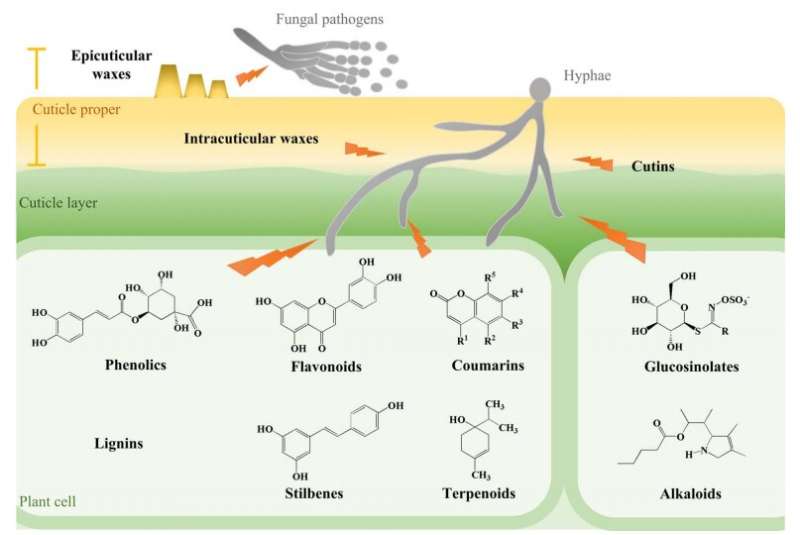Physical barriers and phytochemicals involved in resistance of horticultural crops to fungal pathogens. Credit: Nanjing Agricultural University The Academy of Science
Recently, scientists from the Chinese Academy of Sciences summarized recent research progress on defense responses of horticultural crops to fungal pathogens and novel strategies to regulate the induction of plant resistance, as well as problems, challenges, and future research directions.
Phytochemicals with antimicrobial effects are important components of defense systems in plants. Among such phytochemicals, phytoalexins are induced by external factors, whereas phytoanticipins occur naturally or increase after induction. Antimicrobial phytochemicals are classified according to their chemical structures and are primarily phenolics, flavonoids, coumarins, lignins, terpenoids, alkaloids, glucosinolates, and stilbenes. Phenolics and flavonoids are secondary metabolites that constitute one of the most common and extensive groups of phytochemicals. These compounds inhibit pathogens by inducing membrane lipid peroxidation, which disrupts fungal cell membrane permeability and mitochondrial function. Similarly, terpenoids inhibit fungal growth and also induce disease resistance. The other phytochemicals also exhibit strong and stable broad-spectrum antifungal activity, suggesting that they could be developed as alternatives to chemical fungicides.
When fungal pathogens penetrate physical barriers by modifying or degrading host cell walls, pattern recognition receptors (PRRs) may recognize conserved damage-associated molecular patterns (DAMPs) from plants or pathogen-associated molecular patterns (PAMPs) from pathogens and activate pattern-triggered immunity (PTI). Fungal pathogens can secrete effectors or virulence factors, which may be recognized by nucleotide-binding and leucine-rich repeat (NB-LRR or NLR) proteins and other plant resistance (R) proteins. Such recognition may result in further effector-triggered immunity (ETI), which is postulated to be an accelerated and amplified PTI response. A varied number of NB-LRR genes exhibit special evolutionary patterns among plant species. To date, only a few NB-LRR genes have been confirmed to function in response to fungal pathogens. Further in-depth exploration of potential NB-LRRs and their mechanisms of action may substantially enrich our arsenal to counterstrike against fungal pathogens.
To prevent further fungal pathogen invasion, plants have developed a series of responses that include the hypersensitive response (HR), cell wall modification, stomatal closure, callose deposition, phytoalexin production, and toxin degradation. After local defense responses are induced, systemic signaling may activate resistance in other adjacent tissues. Both PTI and ETI can trigger the production and long-distance transport of signaling molecules to induce systemic acquired resistance (SAR) and herbivore-induced resistance (HIR). SAR is mediated primarily by salicylic acid (SA) signaling and to a lesser extent by N-hydroxypipecolic acid (NHP). In contrast to SAR, HIR is modulated by jasmonic acid (JA) and ethylene (ET). Crosstalk among SA, JA, and ET, both synergistic and antagonistic, is common and crucial for defense responses against fungal pathogens.
The overuse of traditional fungicides and antimicrobial agents has increased pathogen resistance to these compounds and also threatens food safety and the environment. Therefore, new strategies must be developed for efficient disease control to meet requirements for the sustainable development of the agricultural industry. The latest studies indicate that the induction of intrinsic resistance in horticultural crops via regulatory elements is both feasible and efficient. The discovery of cross-kingdom RNA trafficking has provided new prospects for crop protection. The necrotrophic fungus B. cinerea can produce small RNAs (sRNAs) that function as effectors to suppress host immunity. In turn, host plants introduce sRNAs into B. cinerea via extracellular vesicles that suppress the expression of genes associated with pathogenicity. Overexpression or knockdown of transferred host sRNAs can either promote or reduce host resistance. Environmental double-stranded RNA (dsRNA) can be taken up by many eukaryotic microbes with varying efficiency, and topical application of dsRNA with high RNA uptake efficiency can markedly inhibit plant disease symptoms.
Translational control of mRNA through the editing of regulatory elements may be another efficient way to induce resistance in horticultural crops. Upstream open reading frames (uORFs) have widespread regulatory roles in modulating mRNA translation in eukaryotes. Moreover, transgene-free lines of plants with improved traits are readily obtained with CRISPR/Cas9, which has broad implications for crop improvement. Because uORFs are found extensively in eukaryotic mRNAs, these regulatory elements could be manipulated to enhance broad-spectrum resistance with minimal adverse effects on normal growth, substantially promoting the genetic improvement of horticultural crops.
"Because of the importance of fungal disease in pre- and postharvest loss of horticultural crops, we focused on plant-pathogen interactions and control technology. Moreover, development and application of omics technologies have provided large data sets at multiple levels, which have further broadened insights into the defense responses against fungal pathogens," Prof. Tian said. The review paper also examined the limitations of previous studies and proposed future research directions for genetic improvement of resistance in horticultural crops.
The research was published in Horticulture Research.
More information: Xiaodi Xu et al, Molecular mechanisms underlying multi-level defense responses of horticultural crops to fungal pathogens, Horticulture Research (2022). DOI: 10.1093/hr/uhac066
Provided by Nanjing Agricultural University The Academy of Science
























